From 2010/11 to 2018/19, Sevilla finished in the top four on just one occasion in those nine separate campaigns.
The Andalusian club had been in the UEFA Champions League several times in that period but had qualified by winning three Europa League titles on the bounce under Unai Emery from 2014 to 2016, and then grabbing fourth in 2016/17 under Jorge Sampaoli.
In 2019, after a rather disappointing season where the men’s first-team finished below Getafe and managed to finish just sixth in the table, the board were in the market for a new manager, someone who could try and finish in the top four consistently. Enter Julen Lopetegui.
In the first half of 2018, the coach’s stock was rapidly rising but came crashing down to earth after being dismissed from the Spanish national team and Real Madrid within months of each other.
But when Sevilla came, it was a no brainer. They crossed each other’s paths at the perfect moment. The 2021/22 season marked the end of Lopetegui’s third full campaign in charge of Sevilla. The Spanish giants have never failed to finish outside the top four and even managed European glory in 2020, winning the Europa League once more.
However, it would seem as though Lopetegui’s tenure is coming to a rather stale end. Sevilla had mounted a title challenge this season but ended the campaign with a whimper, winning just twice in their final eleven matches to scrape fourth.
But what were the reasons behind this eyebrow-raising drop off?
This Julen Lopetegui tactical analysis will look to answer these questions in the form of a team scout report.
Formation and style
Lopetegui comes very much from the Spanish school of coaching, employing a very possession-based style of play since he took the job in the dugout at the Ramón Sánchez Pizjuán Stadium. This won’t come as a shock to anyone who has watched the Sevillistas Los Rojiblancos over the past three seasons.
In the 2021/22 campaign, Sevilla averaged 59.8 percent ball possession on average per game which was the third-highest behind the possession kings Barcelona and champions Real.
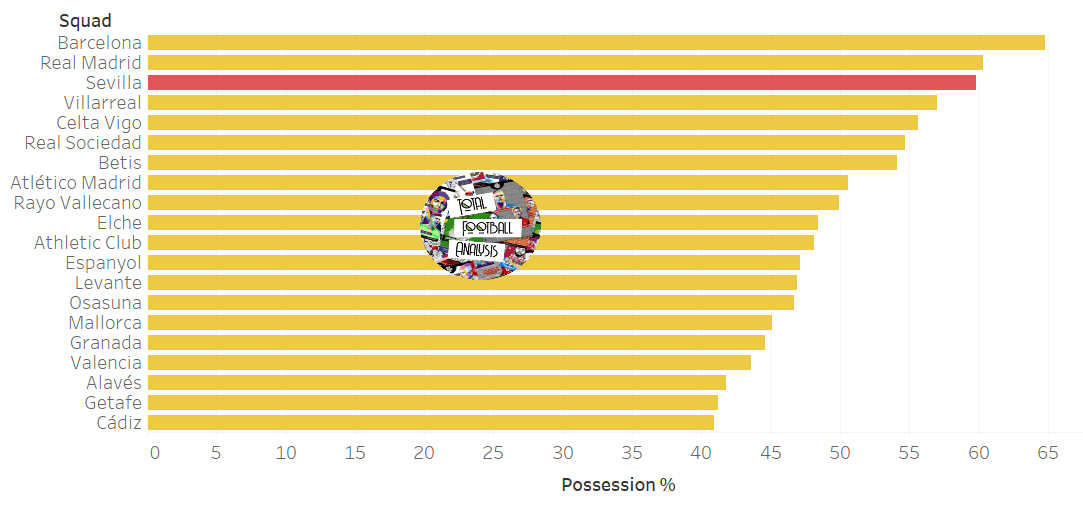
Out of possession, Sevilla are a team that want to press high and get in the faces of the opposition, trying to win the ball in dangerous areas of the field by forcing the ball carrier into making mistakes.
In contrast to the rest of La Liga in the season that has just drawn to a close, Lopetegui’s side have one of the lowest Passes allowed Per Defensive Action rates with 8.55, beaten only by Barcelona and Celta de Vigo.
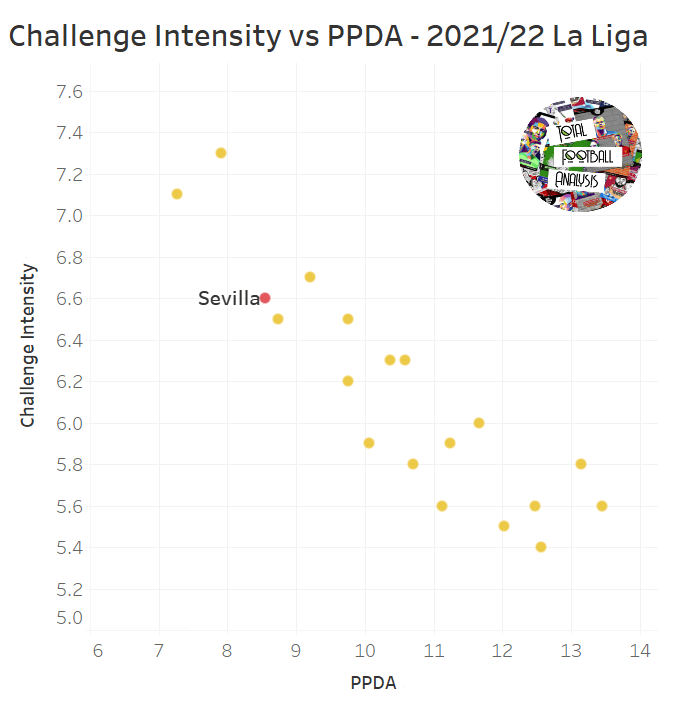
The team’s challenge intensity, which measures how many defensive actions a team makes per minute of opposition possession, stands at 6.6, the fourth-highest in the division. Sevilla press high and emphasise ball retention – a team that are truly symbolic of the modern era in Spain.
Keeping in line with being a stereotypical Spanish side, Sevilla also set-up in a 4-3-3 for the most part, although Lopetegui certainly hasn’t been a stranger to changing formations to suit certain opponents.
The 4-3-3, including its more defensive brother 4-1-4-1, have been used in 37 percent of Sevilla’s game this season in all competitions.
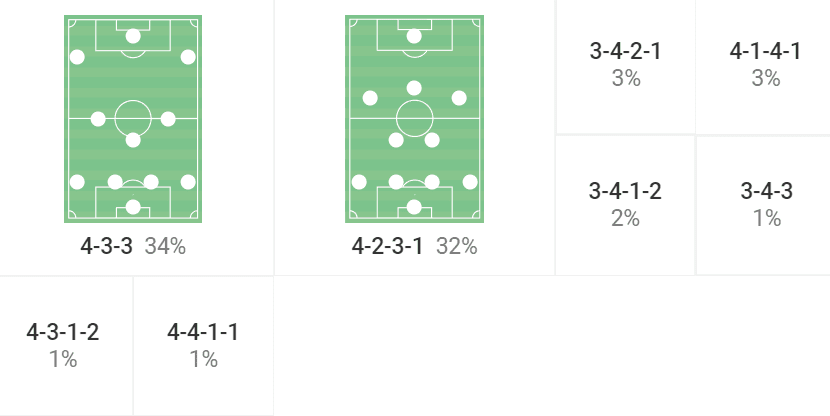
Nevertheless, the Andalusian club have been very adept in other tactical systems, sifting from midfield diamonds to the 3-4-3 to a more conservative 4-2-3-1 with two sitting pivot players protecting the backline.
The 4-2-3-1 accumulated almost one-third of Sevilla’s formation selections in the 2021/22 campaign, although the 4-3-3 still reigned supreme.
Formational flexibility isn’t necessarily a bad thing. Sides like Atletico Madrid, West Ham United and even Bayern Munich can play in a multitude of different structures and can still maintain a high level of consistency.
However, given that Lopetegui was far more congruous in the previous two seasons with his employment of the 4-3-3, using it in 63 percent of Sevilla’s games in 2019/20 and 56 percent in 2020/21, it would hint at the manager not being overly confident with the system this time around.
Now, let’s take a look at the tactics of Sevilla to find out exactly why the side have struggled in recent months.
Pressing drop
Sevilla’s PPDA was very inconsistent throughout the 2021/22 season. Starting off relatively high, it took a dip after the first ten games, meaning the side were allowing the team in possession to make fewer passes on the ball.
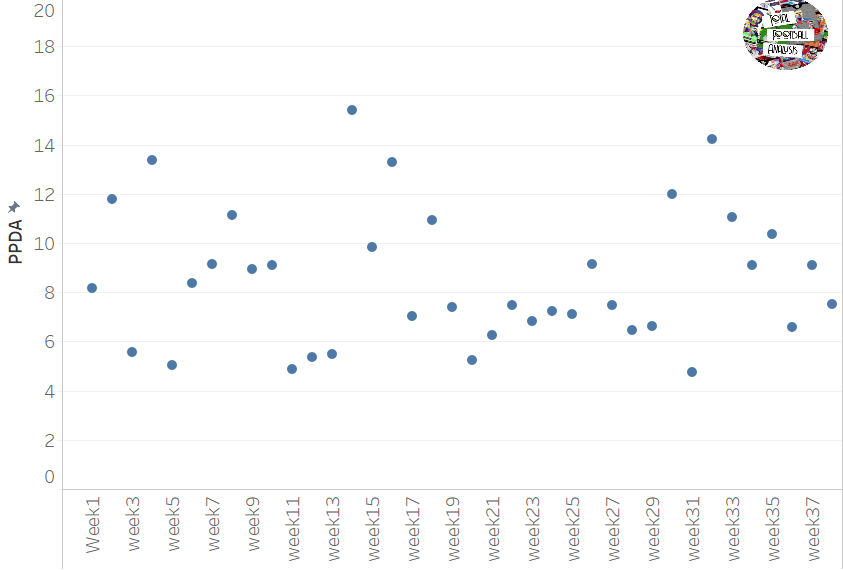
In the matches leading up to Christmas, Sevilla’s PPDA rapidly increased once more to its highest point of the season in a flurry of three games where the Andalusians were forced to face Real Madrid, Villarreal and Athletic Club.
After dipping again until near the end of the campaign, reaching an all-season low of 4.77 against the newly-relegated Granada, Sevilla’s pressing decreased in the final few matches of the season.
This increase in PPDA in the final seven matches is not necessarily correlated to the side’s poor run of form during the same time period. However, looking at their some of their performances towards the back end of the season, Sevilla looked really easy to play through at times when they pressed higher.
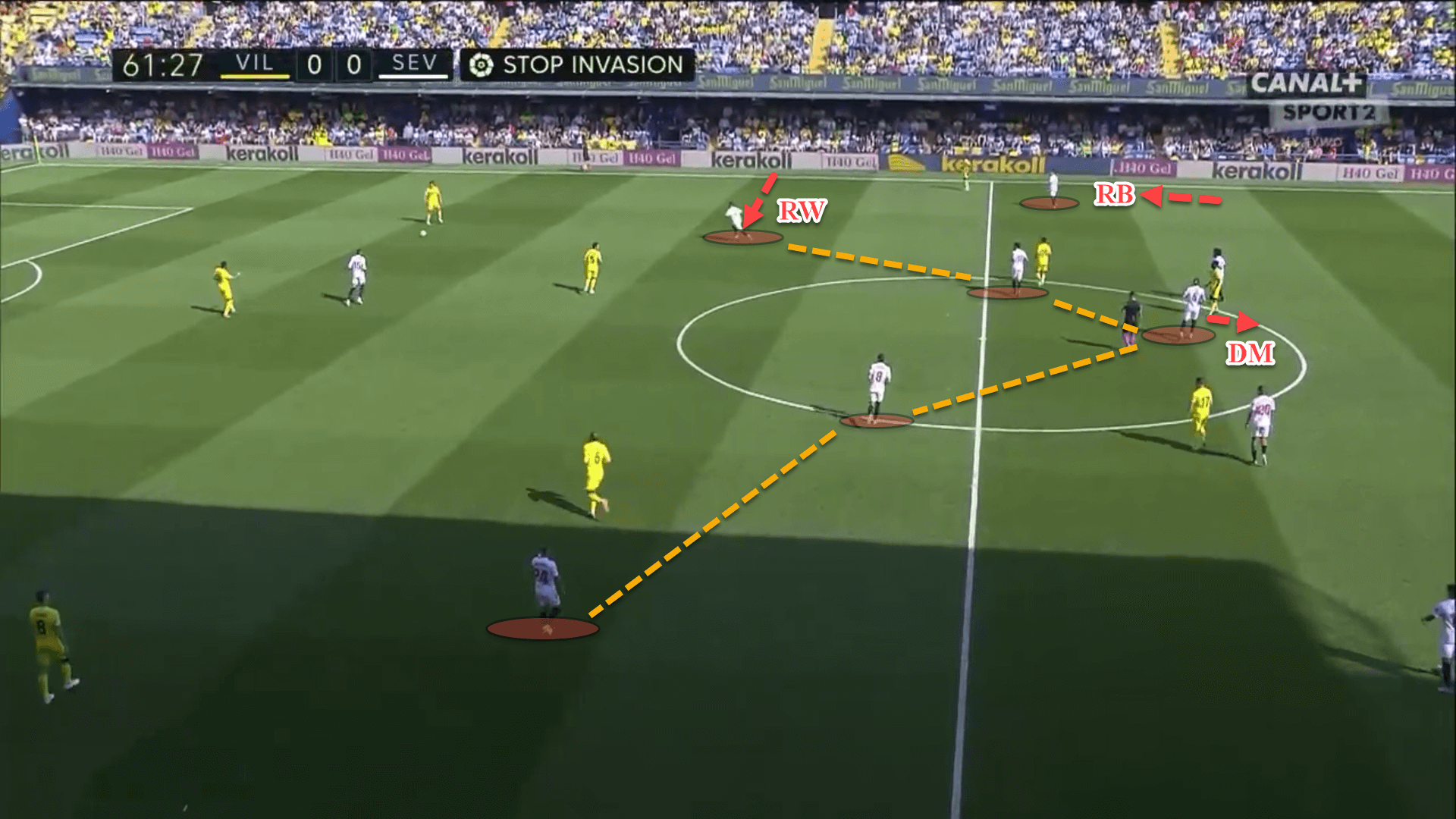
What’s noticeable about Sevilla in the defensive phases is that the team are not very compact. Players are tasked with defending optionally. Essentially, they will mark or press the closest option to them, often leaving a player they are marking to apply pressure to the ball carrier.
This can be problematic against sides who utilise midfield rotations constantly in the middle of the park, such as Unai Emery’s Champions League semi-finalists Villarreal, as it often means that the players can be outnumbered two to one in certain situations.
It certainly doesn’t help that Lopetegui tasks his deepest midfielder with dropping into the backline, playing aggressively and zonally against any player between the lines.
In their recent bout, Sevilla were ripped open on several occasions against The Yellow Submarine while trying to stifle their opponent’s build-up play.
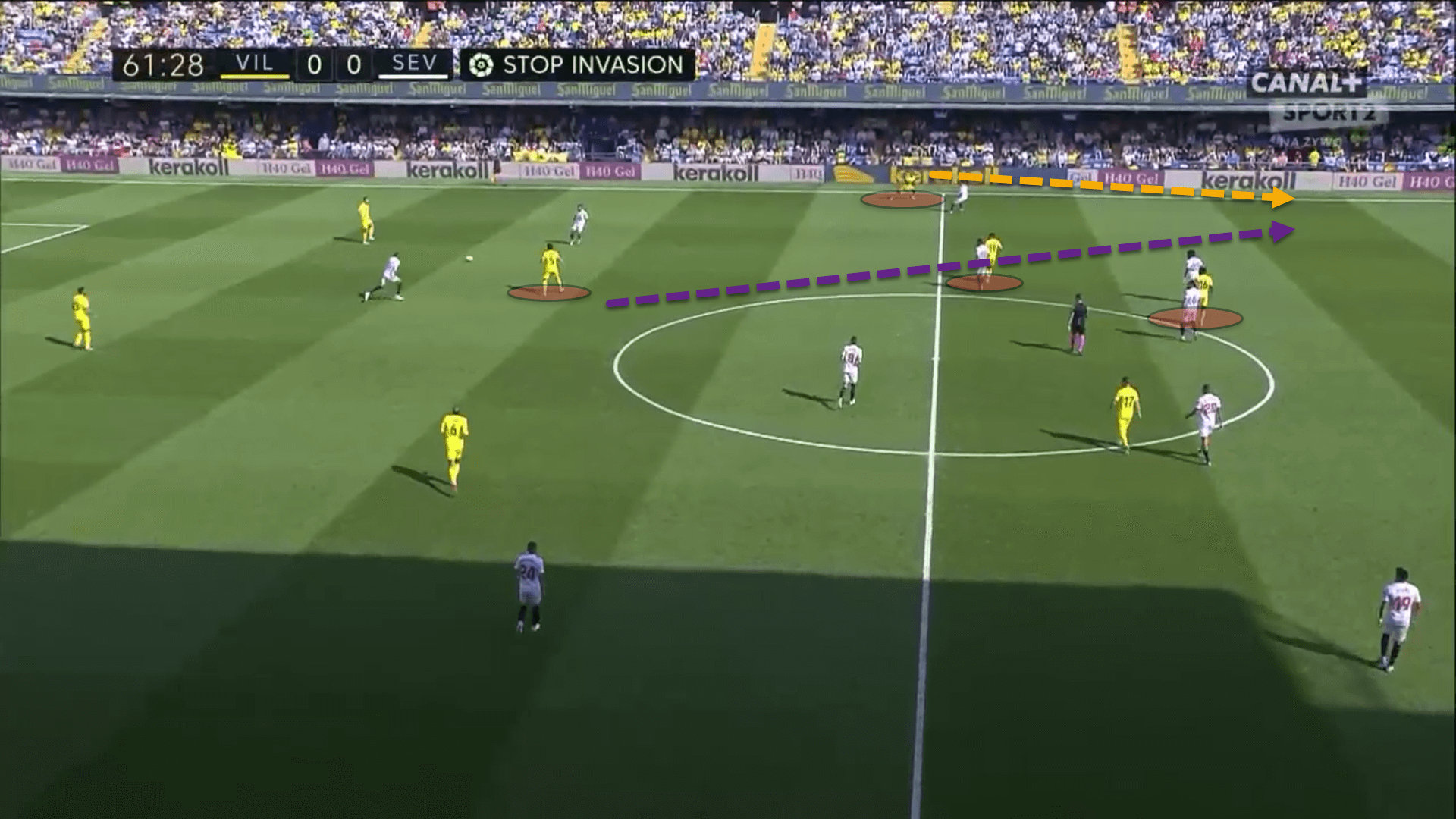
Villarreal would constantly ensure that Sevilla’s players were occupied and pinned down. Emery’s centre-forward had pinned Sevilla’s right centre-back, leaving the right-back with a 1v1 situation over on the left flank.
Dani Parejo received the ball in the middle of the park, turned on it unscathed and quickly played a sumptuous pass into the channel behind Sevilla’s right-back who had stepped up to press his opposite number.
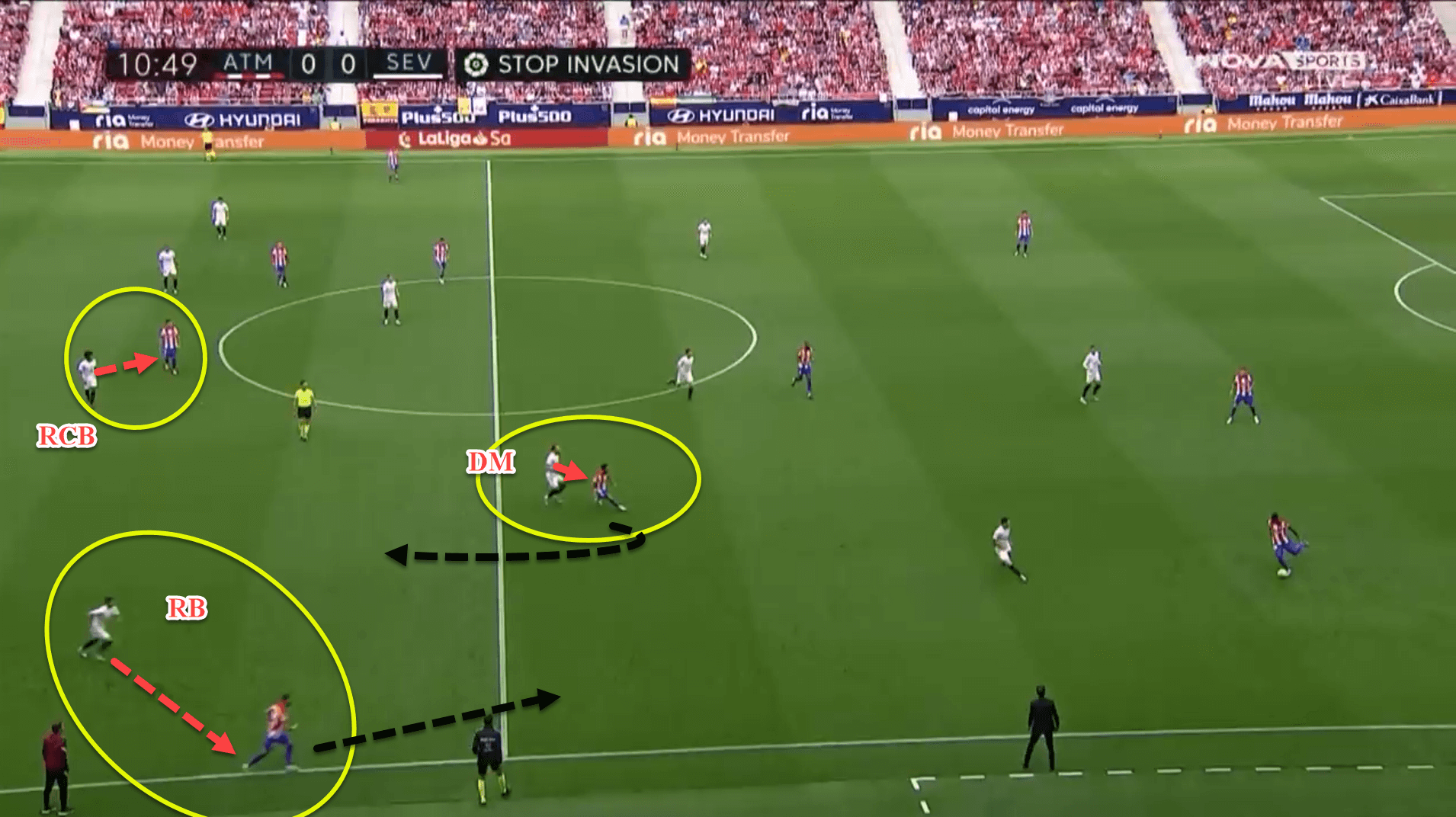
Again here, Sevilla are pressing with a high line and a very similar situation occurs. Sevilla’s pressing approach can often leave them in man-oriented situations where they can be beaten simply by quality in a defensive duel.
If Leeds United under Marcelo Bielsa have thought us anything is that man-marking can be far too easy to play against using dis-marking and combination play.
Given their defensive structure is not compact horizontally, attacking sides can almost force Sevilla into a man-to-man approach, and then look to beat them with quality.
Lopetegui’s men lacked urgency and intensity in their pressing coming towards the end of the campaign. When this happens, once teams like Real Madrid, Villarreal and Atletico Madrid have matched their intensity, they were able to do serious damage by beating them with their quality.
Low goalscoring opportunities
When analysing Sevilla’s play in possession, their keenness to play down the flanks is obvious. Under the Basque manager, the Sevillistas Los Rojiblancos constantly create wide overloads when trying to break down their opposition’s defensive block.
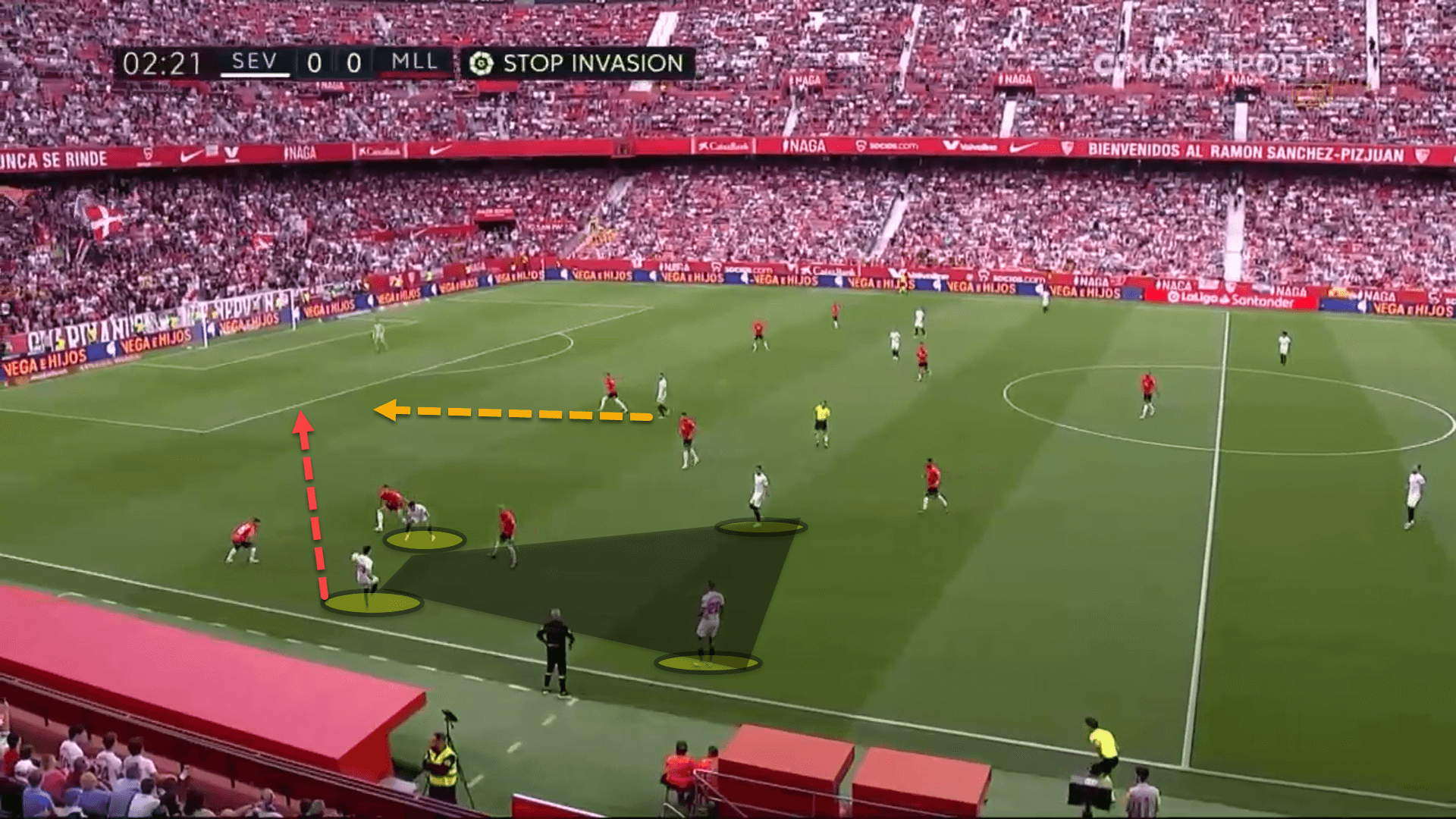
Wide overloads are an excellent way of wearing down an opponent by utilising the superior quality of the players to combine with the ball and use third-man runs to get in behind.
When executed effectively, teams can get players into optimal positions to cross the ball. Crosses are one of Sevilla’s main forms of attacking. Lopetegui’s side averaged 14.6 crosses into the box per 90, the fourth-highest in La Liga.
In a recent goalless draw with Mallorca, Sevilla accumulated 41 crosses in total which is utterly mind-blowing, failing to convert a single one of them. There was a shade of Manchester United’s infamous 81-cross 2-2 draw with Fulham in 2014 about it.
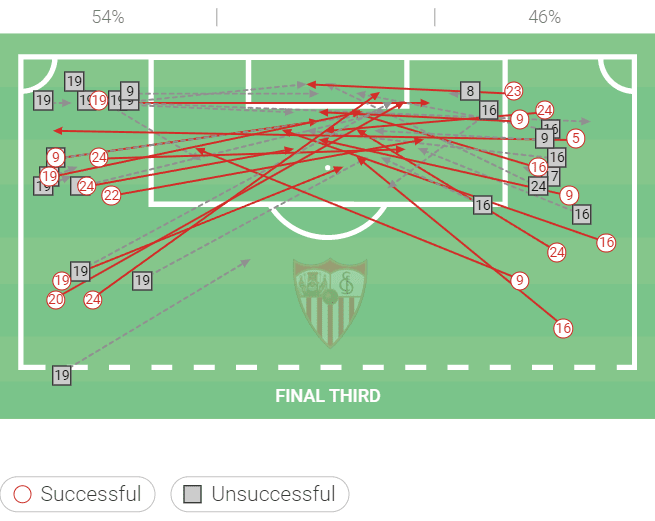
Sevilla also completed 85 headed shots over the course of the league campaign. Only Rayo Vallecano bettered this number.
However, statistically, chances from the flanks have a much lower chance of leading to a goal.
In the final ten games of the season, Sevilla boasted a combined total of 305 positional attacks. Only 85 were through the central corridors, meaning 220 were down the sides or 72.1 percent of their positional attacks. For example, here is a data visual displaying all 49 of Sevilla’s positional attacks against Mallorca in the goalless draw at the Ramón Sánchez Pizjuán.
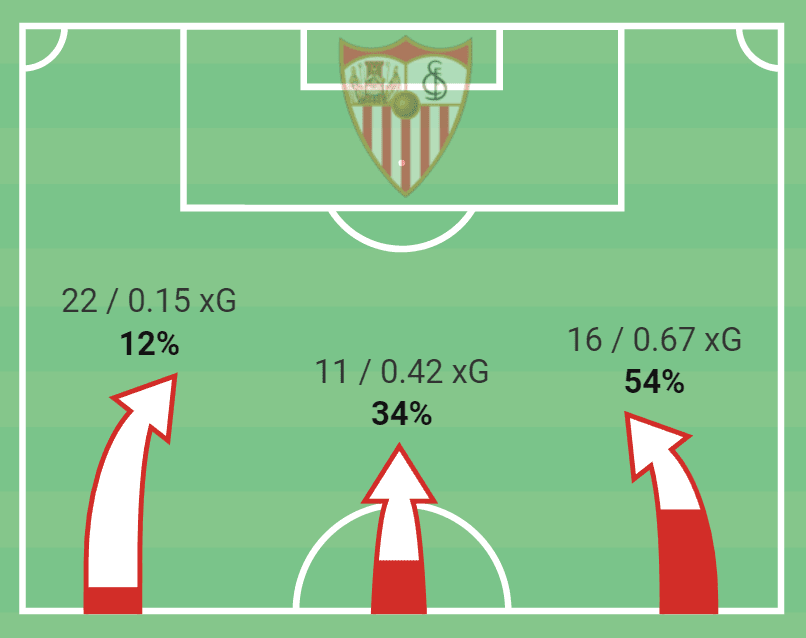
Nevertheless, the team’s total xG for the league campaign stood at 45.93, the eighth-lowest in Spain’s top flight. Sevilla’s xG per shot was 0.114, the seventh-lowest.
Sevilla did score the second-most headed goals in the league with 11. However, 11 from 687 total crosses is really not a great return overall.
The Andalusians had plenty of wingers in their ranks. Talents such as Anthony Martial, Lucas Ocampos, Erik Lamela, Jesus Corona and Alejandro Gomez are all extremely useful out in the wide areas. But the team were lacking dominant players between the lines who are able to receive in these tight spaces and create high-quality goalscoring opportunities.
Sevilla have just one player in the top 30 for the highest expected assists in La Liga and it’s Jesus Navas, who plays as a right-back for the team.
Neglecting the red zone
In football analysis, the space between the midfield and backline is often called ‘the red zone’. Teams like Manchester City, Barcelona, Chelsea and Bayern Munich dominate this area of the pitch, looking to manipulate the opposition’s deep defensive block and smash down their walls.
Having quality in this area is of paramount importance for possession-oriented sides. However, following on from the previous section, Lopetegui is forced to neglect space occupation in the red zone to focus on wing-play because there are a lack of players in the squad’s ranks comfortable playing in these tight spaces.
Sevilla’s wingers position themselves very wide, often to combine with others on the flanks during wide overloads, instead of coming inside between the lines.
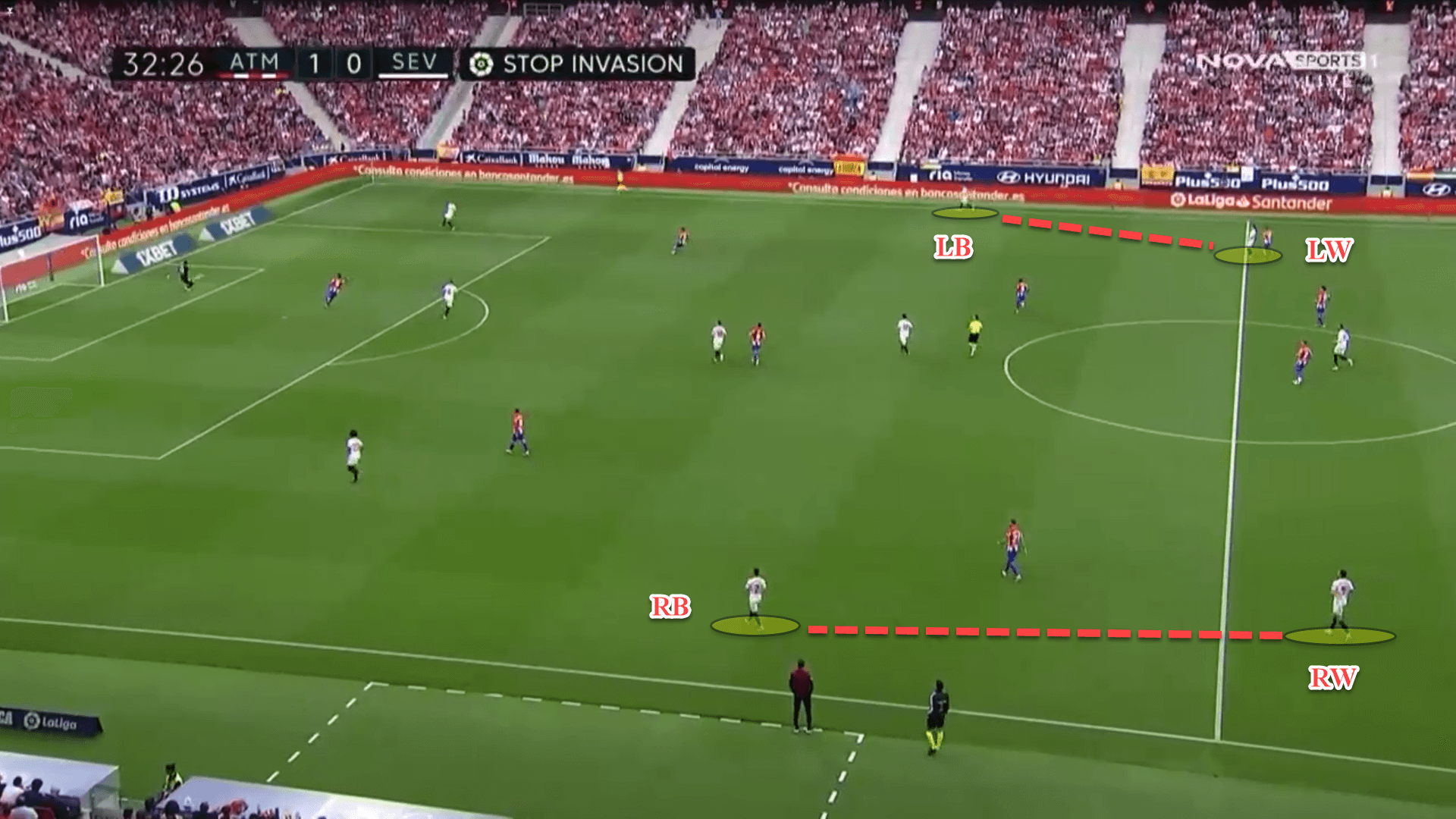
Generally, it is the central midfielders who are tasked with pushing up into the halfspaces in the red zone.
This is a ploy used by Pep Guardiola’s Man City with players like Kevin de Bruyne and Bernardo Silva dominating the halfspaces during games, especially against teams that sit in a deeper defensive block in order to unlock them by dragging players out of position.
Unlike his Spanish counterpart, Lopetegui doesn’t have players of this quality in the side and instead prefers his ‘8s’ to make runs in behind to try and get into good positions to put crosses into the area.
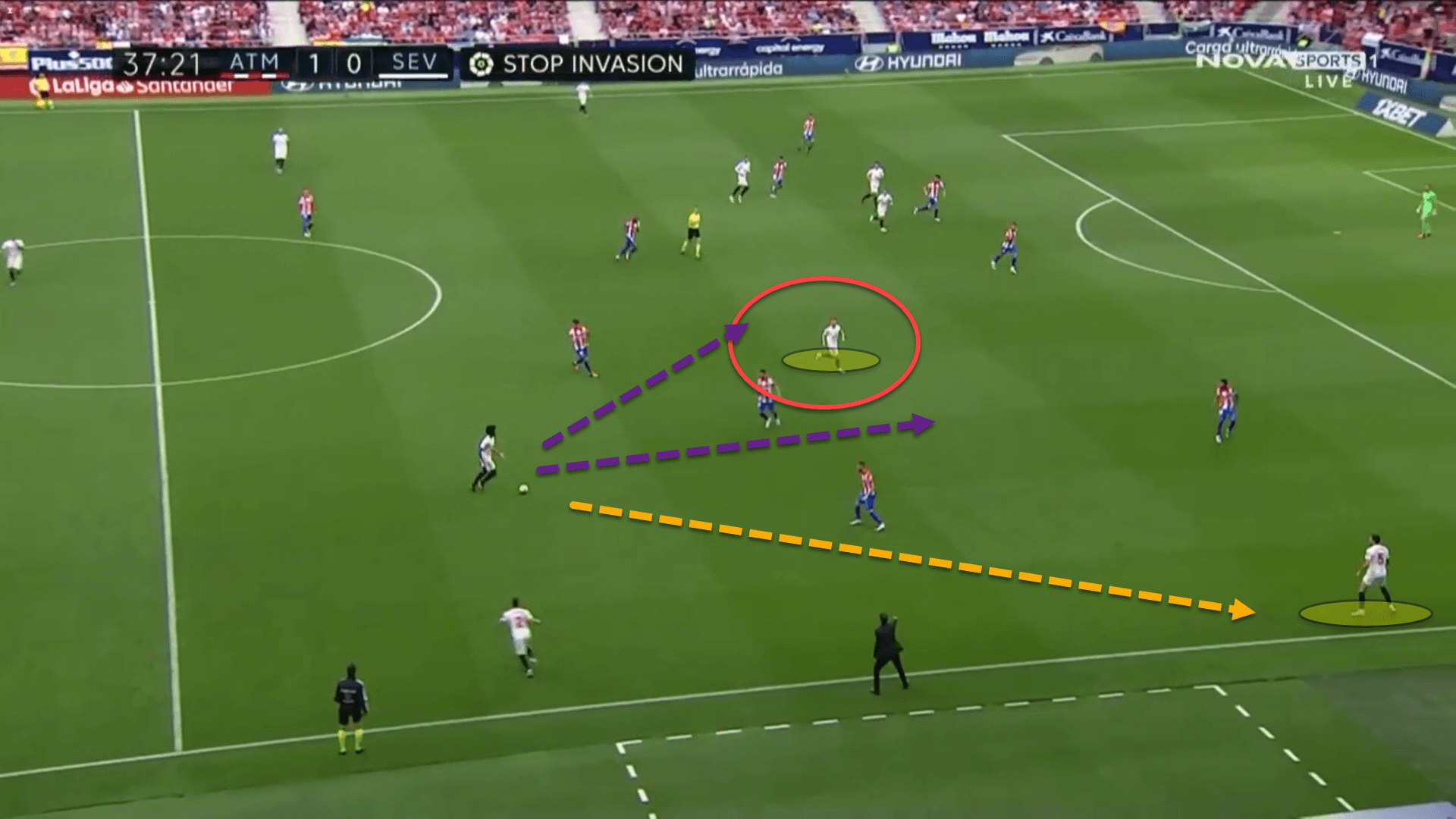
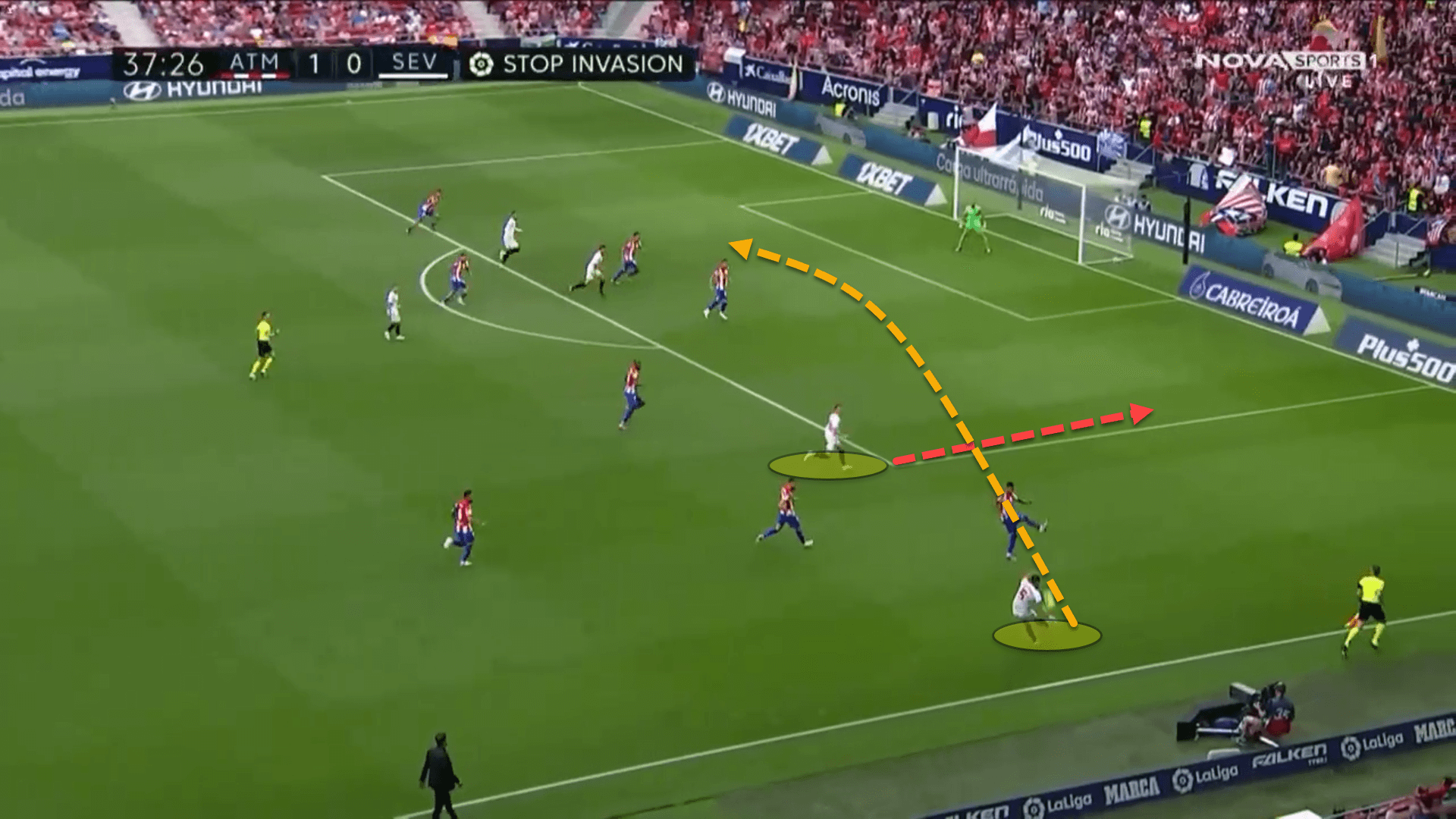
For instance, here, Ivan Rakitic had a wonderful opportunity to call for the ball between the lines before turning in the central area and trying to slip a runner in behind.
Instead, Kounde played wide to Ocampos who crossed it into the area while Rakitic continued his halfspace run in behind. The cross was easily cleared away by Diego Simeone’s dogged backline.
It’s quite a strange situation that Sevilla have found themselves in. The Rojiblancos play a possession style in the first two-thirds of the pitch before becoming quite a predictable crossing team in the attacking third.
Conclusion
It seems to have gone incredibly stale for Julen Lopetegui at Sevilla. The Andalusian club, under Basque guidance, have gone from their usual swashbuckling, inventive selves, to a team void of creativity, resorting to lumping balls into the box.
Playing crosses is not an issue but teams need to be unpredictable and switch things up, sifting between trying to create chances out wide to attempting to create chances centrally. However, the Rojiblancos don’t have the capabilities to do this and have become far too predictable.
Lopetegui’s tenure in Seville has been nothing short of a success. Unfortunately, though, he may not be the man to take them forward anymore, according to the recent reports.
On their day over the past three years, Sevilla could play like a Rolls Royce on smooth tarmac. But recently, the side have found themselves on some rocky, mountainous terrain. The board need to decide whether they want to put some new wheels on, or else replace the driver.






Comments